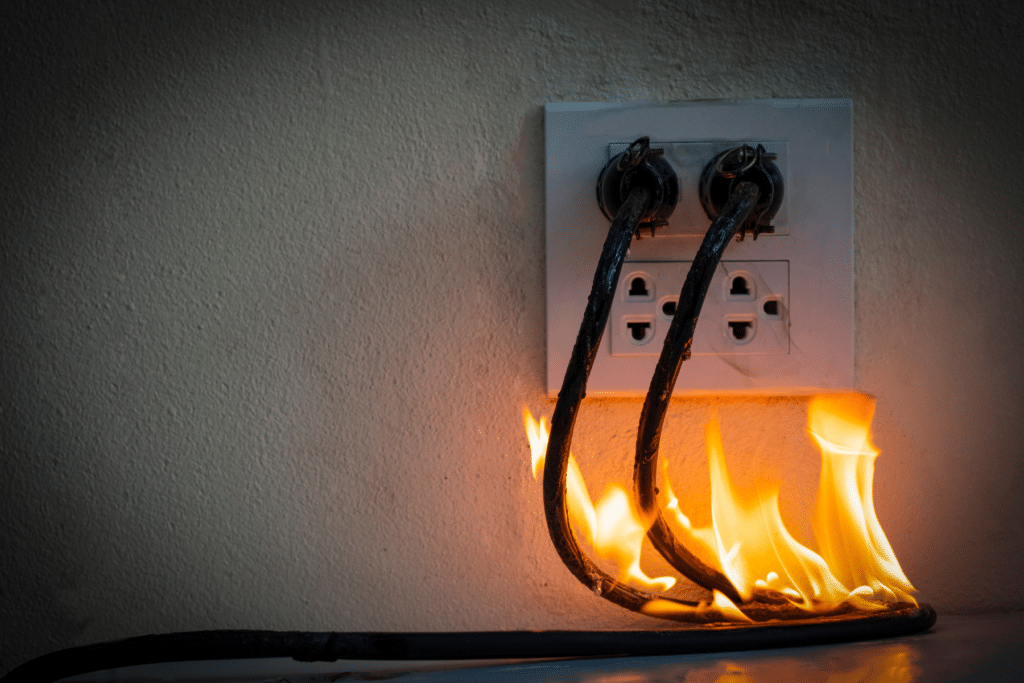Key Highlights
- Circuit breakers are electrical switches designed to protect circuits from damage caused by overcurrent or short circuit.
- They play a crucial role in home safety by interrupting current flow when a fault is detected.
- Understanding different types of circuit breakers and their applications is for effective circuit protection.
- Common reasons for circuit breaker trips include overloaded circuits and short circuits.
Understanding Circuit Breakers and Home Safety
To understand the role of circuit breakers in home safety, it’s important to know how they work. Circuit breakers detect abnormal electrical conditions and interrupt the flow of current to prevent system damage. Protective relays monitor the current and trip the breaker when necessary, opening and closing the main contacts. This provides a crucial layer of protection against electrical hazards. In Metro Detroit, Leopard Electric is here to help you understand and maintain your circuit breakers for a safe home.
The Role of Circuit Breakers in Your Home
Circuit breakers are essential for maintaining electrical circuit safety and functionality in your home. They protect wiring from damage by cutting off power during faults like overloads or short circuits. This prevents overheating and reduces the risk of electrical fires, ensuring your home’s electrical system operates safely.

How Circuit Breakers Prevent Electrical Hazards
Circuit breakers play a crucial role in preventing electrical hazards in your home. Here are some ways they achieve this:
- Short Circuits: When a short circuit occurs, the circuit breaker quickly interrupts the flow of current to prevent excessive current from flowing through the circuit.
- Ground Faults: Circuit breakers equipped with Ground Fault Circuit Interrupters (GFCIs) can detect ground faults, which occur when the electrical current takes an unintended path to the ground. The GFCI trips the circuit breaker to prevent electric shock.
- Arc Faults: Circuit breakers with Arc Fault Circuit Interrupters (AFCIs) can detect arc faults, which occur when electrical current jumps across a gap in a circuit, creating sparks. The AFCI trips the circuit breaker to prevent fire hazards.
- Overloads: Circuit breakers can detect when a circuit is overloaded, meaning that it is carrying more current than it is designed to handle. The breaker trips to prevent overheating and potential damage to the circuit.
By promptly interrupting the flow of current in these situations, circuit breakers help to protect your home and its occupants from electrical hazards.
Common Reasons for Circuit Breaker Trips
Circuit breakers can trip due to various reasons, such as overloaded circuits and short circuits. Prevent trips by avoiding connecting too many devices to a single circuit and addressing any direct connections between wires. Maintaining your electrical system’s safety is key.
Overloaded Circuits: Causes and Solutions
Circuit breakers are crucial for your home’s electrical circuits, protecting them from damage caused by excess current. In case of a fault like overload or short circuit, protective relays trip the breaker to cut off power, preventing damage and reducing fire risk. Circuit breakers ensure the safe operation of your home’s electrical system.
Short Circuits: Identifying and Handling
Short circuits occur when wires are directly connected, bypassing normal current flow, leading to circuit breaker trips and fire hazards. Identifying and fixing short circuits is crucial for electrical safety. Signs include power loss, tripped breakers, sparks, or smoke. If you suspect a short circuit, turn off the affected circuit’s breaker and address the issue promptly. Seek professional help if needed.

Standard Circuit Breakers and Their Applications
Standard circuit breakers are the most common type used in homes and are designed for general circuit protection. They come in various amp ratings to accommodate different electrical loads. Here are some common applications of standard circuit breakers:
- Lighting Circuits: Standard circuit breakers are used to protect lighting circuits, ensuring that the current flow remains within safe limits.
- Outlets and Receptacles: These circuit breakers provide protection for outlets and receptacles throughout the house, preventing damage from overcurrent or short circuit.
- Appliance Circuits: Standard circuit breakers are also used to protect circuits dedicated to specific appliances, such as refrigerators, air conditioners, or washing machines.
- Motor Circuits: Circuit breakers with motor protection capabilities are used to safeguard motor circuits, preventing damage from overload or short circuit conditions.
By selecting the appropriate amp rating for each circuit, you can ensure reliable circuit protection and maintain the safety of your electrical system.
GFCI and AFCI Breakers: Enhancing Safety
Short circuits occur when a direct connection is made between the hot wire and the neutral wire or ground, bypassing normal current flow. They can cause circuit breaker trips and fire hazards. Identifying and handling short circuits is crucial for electrical safety. Signs include power loss, tripped breakers, sparks, or smoke. If you suspect a short circuit, turn off the associated circuit breaker immediately. Correct the issue like damaged wiring or faulty appliances. If unsure, seek professional electrical services for a safe resolution.
Signs Your Home Needs Circuit Breaker Upgrades
If you notice frequent tripping of your circuit breaker, especially when multiple appliances are in use, it might be time for an upgrade. Another sign is if your breaker panel feels hot to the touch or emits a burning smell, indicating potential overloading. Dimming or flickering lights, which can point to irregular electrical flow, also signal the need for an inspection. Keep an eye out for regularly needing to reset your circuit breaker or if it fails to trip during a fault, jeopardizing safety measures. Ignoring these signs could lead to electrical hazards or even fires, emphasizing the importance of timely upgrades.
Frequent Tripping and What It Signals
Frequent tripping of circuit breakers is a common issue that may indicate underlying problems with your electrical system. It can be caused by a variety of factors, including:
- Overloaded Circuits: If you are using too many appliances or devices on a single circuit, it can exceed the circuit’s capacity and cause the breaker to trip.
- Faulty Appliances: A faulty appliance can cause short circuits or overloads, leading to frequent tripping of the associated circuit breaker.
- Wiring Issues: Damaged or outdated wiring can cause irregular current flow, resulting in frequent breaker trips.
- Faulty Breakers: Aging or defective circuit breakers may trip more frequently, signaling the need for replacements.
If you are experiencing frequent tripping, it is important to investigate the underlying cause. Consulting a professional electrician can help identify and address the issues, ensuring the safety and optimal performance of your electrical system.
Physical Damage to Breakers: A Red Flag
Physical damage to circuit breakers like cracks or burn marks is a warning sign not to be overlooked. Damaged breakers compromise safety and functionality, potentially leading to electrical fires or system damage. Promptly replace any damaged breakers to maintain a safe and reliable electrical system. Regular inspection and timely replacement are crucial for home safety.

DIY vs. Professional Electrical Services
When it comes to electrical services, such as installing or upgrading circuit breakers, you may be wondering whether to tackle the job yourself or hire a professional. While simple tasks like replacing a breaker may be suitable for DIY, it is important to consider the complexity and potential risks involved. For more complex tasks, such as service panel upgrades or troubleshooting electrical issues, it is recommended to hire a licensed electrician. Professionals have the knowledge, skills, and tools necessary to ensure the job is done safely and efficiently, minimizing the risk of accidents or electrical problems down the line.
When to Call Leopard Electric
For safe and professional electrical work in your home, Leopard Electric is the trusted choice. Their team of skilled electricians prioritizes safety and excels in proper circuit breaker installation and maintenance. By relying on Leopard Electric, you can steer clear of DIY risks and potential accidents that may arise from attempting electrical work yourself. From routine maintenance to complex installations, Leopard Electric is committed to providing top-notch service for all your electrical needs. Contact Leopard Electric today for peace of mind and expert electrical solutions.
The Dangers of DIY Electrical Work
It’s risky to attempt DIY electrical work due to potential dangers like electrical shock, fires, and fatalities. Mistakes can void warranties and insurance coverage, leading to costly repairs and legal issues. Trust professional electricians for safe handling of electrical tasks. Contact Leopard Electric for your electrical needs and prioritize safety for you and your loved ones.
Installing and Maintaining Circuit Breakers
Proper installation and maintenance of circuit breakers are crucial for your home’s electrical safety. Faulty connections from improper installation or neglected maintenance can lead to breaker failure when needed most. Follow a guide for safe installation, conduct routine checks, and consider hiring a professional electrician like Leopard Electric for expert assistance in ensuring your home’s safety.

Routine Checks to Ensure Ongoing Safety
Regular maintenance checks are essential to ensure the ongoing safety and functionality of your circuit breakers. Here are some routine checks you can perform:
- Visual inspection: Check for any signs of damage, loose connections, or corrosion on the circuit breaker.
- Test button: Press the test button to simulate an overload and check if the breaker trips correctly. Reset the breaker after testing.
- Amp reading: Use a multimeter to measure the amperage of the circuit and compare it to the rated amperage of the breaker.
- Circuit labeling: Ensure that all circuits are appropriately labeled for easy identification and troubleshooting.
- Cleanliness: Keep the breaker panel clean and free from dust or debris that can interfere with its performance.
Performing these routine checks at regular intervals can help identify any potential issues before they become major problems. If you’re unsure about how to perform these checks or notice any abnormalities, it’s best to consult a professional electrician like Leopard Electric to ensure your home’s electrical safety.
Tips for Preventing Circuit Breaker Issues
To prevent circuit breaker issues, manage home appliances to avoid overloads. Use electrical safety devices and regularly check wiring for faults. Insulate the breaker panel properly and be mindful of appliance amperage requirements. Consult experts for installation and maintenance. High current or voltage surges may cause breaker failure, requiring replacement. Consider a ground fault circuit interrupter (GFCI) for added protection. Follow these tips to maintain your circuit breakers and ensure home safety.
Managing Home Appliances to Avoid Overloads
When setting up home appliances, consider power requirements to prevent overloading circuits. Distribute high-power devices across different circuits and use appliances within recommended voltage ranges. Incorporate safety devices like GFCIs and AFCIs. Save energy by unplugging devices when not in use and avoiding simultaneous use of multiple high-power appliances. Regularly check cords and outlets for wear or damage to prevent short circuits and overloads. Stay informed about each appliance’s electrical requirements for a safe electrical system at home.
Implementing Electrical Safety Practices
Implementing electrical safety practices is essential for protecting your home from electrical hazards and reducing the risk of circuit breaker issues. Here are some important practices to follow:
- Use electrical safety devices: Install surge protectors to protect sensitive electronic devices from power surges. Additionally, install ground fault circuit interrupters (GFCIs) in areas with water sources to prevent electrical shock.
- Ensure proper insulation: Inspect electrical wiring regularly to ensure that the insulation is intact. Damaged or frayed insulation can lead to short circuits and electrical fires.
- Avoid overloading circuits: Do not connect too many appliances to a single circuit. Distribute the load across multiple circuits to prevent overloads.
- Be cautious with extension cords: Use extension cords sparingly and temporarily. Avoid overloading them and make sure they are in good condition.
By implementing these electrical safety practices, you can create a safer environment in your home, reduce the risk of circuit breaker issues, and protect your electrical system from potential damage.
Keep Your Home Safe With Leopard Electric
When it comes to electrical safety, it’s important to rely on the expertise of professionals like Leopard Electric. With their professional electrical services, you can ensure the safety and functionality of your home’s electrical system. Leopard Electric’s team of skilled electricians is trained to handle all your electrical needs, from installation to maintenance and repairs. They prioritize safety and adhere to industry standards to deliver high-quality services. By choosing Leopard Electric, you can have peace of mind knowing that your home is in the hands of professionals who are committed to providing excellent customer service and ensuring electrical safety.
Frequently Asked Questions
What to Do If a Breaker Keeps Tripping?
If a breaker keeps tripping, it could indicate an underlying issue with the electrical circuit. Start by identifying the cause of the overload or short circuit. If the problem persists, consult a professional electrician to inspect the breaker, trip unit, and other components of the electrical circuit to determine the cause and provide a solution.
Can I Upgrade My Circuit Breakers Myself?
Upgrading circuit breakers requires knowledge of electrical systems and safety precautions. It is not recommended for DIY work as it can pose safety risks. It is best to consult a professional electrician who has the expertise to handle circuit breaker upgrades safely and efficiently.
How Often Should Circuit Breakers Be Replaced?
Circuit breakers have a lifespan of around 30 years with proper maintenance. However, they may need to be replaced earlier if they show signs of wear and tear, such as frequent tripping, buzzing sounds, or overheating. Regular inspections and professional advice can help determine when circuit breakers need replacement.
Why Choose Leopard Electric for Your Electrical Needs?
Leopard Electric is a trusted provider of professional electrical services. With a focus on customer satisfaction, their team of skilled electricians delivers high-quality workmanship and adheres to industry standards. They provide reliable solutions, ensuring the safety and functionality of your electrical system.
Are there any common issues or warning signs that indicate a problem with a circuit breaker?
Common issues with circuit breakers include frequent tripping, flickering lights, buzzing sounds, and overheating. These warning signs indicate potential problems with the breaker or the electrical circuit, and it’s important to address them promptly to prevent safety hazards.


